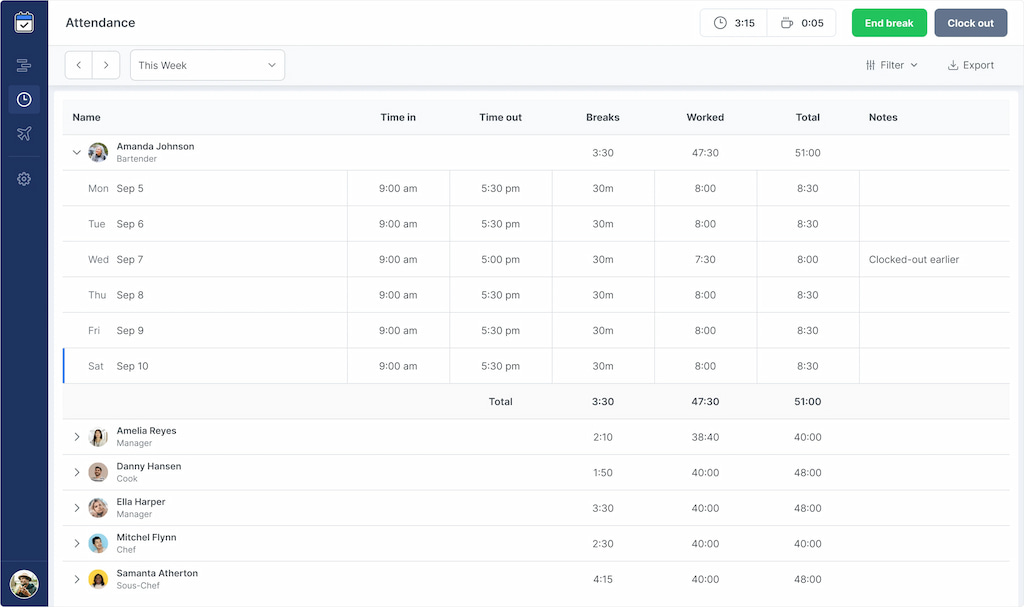In the realm of best employee scheduling software, businesses are increasingly turning to innovative solutions to optimize staff allocation and improve employee satisfaction. One such solution gaining popularity is the concept of open shifts.
In this blog post, we will delve into the world of open shifts, examining their definition, functionality, and the benefits they offer to both businesses and employees.
What Are Open Shifts? Definition and Key Benefits
Open shifts can be defined as unfilled or unassigned shifts within a company’s schedule. Unlike traditional fixed schedules, open shifts offer a dynamic to staff allocation allowing a flexible schedule. Businesses can use open shifts to accommodate fluctuations in demand, unexpected absences, or additional workloads without overburdening current staff.
In practice, open shifts are created when businesses have staffing gaps.
Managers can publish these shifts in real-time through scheduling software. Employees, in turn, receive notifications about these open shifts and have the opportunity to express their interest or bid for the available hours.
How to Efficiently Manage Open Shifts in Your Organization
Open shifts operate through a scheduling platform or communication channel accessible to employees. Here’s a step-by-step breakdown of how the open shifts function works:
1️⃣ Managers proactively publish open shift slots well in advance, giving qualified employees ample time to consider filling them with extra hours or covering a specific shift.
2️⃣ Employees sign up for available open shifts, essentially placing a bid to work during those time slots. Once an employee claims an open shift, it is marked as filled, no longer appearing as an option for other employees.
3️⃣ Manager must review and approve the employee’s bid to fill the vacancy. Once confirmed, the employee is assigned to the shift.
Open Shifts vs Traditional Scheduling: Which Is Right for You?
In traditional shift scheduling, managers create fixed schedules based on projected demand and employee availability. Employees are assigned specific shifts for the entire scheduled period, often weeks or months in advance. This rigid approach can lead to challenges when unexpected changes occur, such as last-minute absences or fluctuating customer demand. Managers may struggle to find replacements, potentially understaffing or overburdening the existing workforce with overtime.
On the other hand, open shifts offer a dynamic and adaptable approach to scheduling. Managers can publish unfilled or unassigned shifts, creating opportunities for employees to bid on and fill those slots based on their availability and preferences. It also enables businesses to respond to staffing needs and fluctuations in demand quickly, ensuring a more agile workforce.
Open Shifts: Industry-Specific Benefits
While open shifts can benefit various industries, certain sectors reap more significant advantages due to their unique operational requirements. Let’s explore a few industries where open shifts make a notable impact:
🛒 Retail industry
In the fast-paced retail sector, customer demand can fluctuate significantly, leading to varying daily staffing needs. Open shifts enable retailers to quickly fill gaps in the schedule caused by unforeseen absences or unexpected surges in customer traffic. For instance, during holiday seasons or sales events, retail stores often experience a surge in foot traffic, and having open shifts allows managers to swiftly secure additional staff to maintain high-quality customer service. Without this flexibility or pick-up shift apps, retailers may struggle to maintain adequate staffing levels during busy periods, potentially leading to dissatisfied customers and lost sales opportunities. It’s one of the best retail scheduling practices to employ open shifts for the workers (and retail employee scheduling software).
💉 Healthcare sector
The healthcare industry operates around the clock, and staffing requirements must always align with patients’ needs. Open shifts provide healthcare facilities, such as hospitals and clinics, the ability to manage unforeseen staffing shortages due to illnesses or emergencies. When medical professionals have the option to volunteer for open shifts, it ensures that critical healthcare services remain accessible to patients without compromising the quality of care. Without open shifts, healthcare organizations might face difficulties in arranging timely replacements for absent staff, potentially affecting patient care and safety.
🛎️ Hospitality and food service
Factors like seasonality, events, and customer demand heavily influence the hospitality and food service industries. Open shifts enable restaurants, hotels, and catering businesses to maintain a flexible workforce that can accommodate varying guest volumes and event schedules. For instance, if a hotel is hosting a conference or a restaurant experiences a surge in reservations, open shifts empower managers to quickly find additional staff to handle the increased workload. Without open shifts, hospitality and food service establishments may struggle to adapt to sudden changes in demand, leading to service delays and dissatisfied customers.
In these industries and many others, open shifts and the best restaurant scheduling software play a crucial role in maintaining operational efficiency, ensuring high-quality service delivery, and supporting employee work-life balance. By leveraging open shifts, organizations can respond swiftly to dynamic situations, optimize workforce utilization, and create a positive work environment for their staff.
Open Shifts and Country-Specific Considerations
Country-specific regulations and labor laws can influence the implementation and use of open shifts in various ways. While the concept of open shifts is generally applicable across different countries, some regions may have specific rules or restrictions that organizations need to consider.
In the 🇺🇸 United States, open shifts are commonly used in industries with variable work demands, such as retail, healthcare, and hospitality. However, labor laws may vary from state to state, impacting how open shifts are managed. Some states have strict regulations concerning employee scheduling and require employers to provide advance notice of work schedules to employees. For instance, certain states mandate “predictable scheduling” laws that address issues like on-call shifts and short-notice schedule changes. Organizations operating in the U.S. need to stay informed about state-specific labor laws and ensure compliance when using open shifts.
In the 🇪🇺 European Union (EU), employee rights and labor laws are generally more protective of workers compared to some other regions. The EU has introduced directives aimed at promoting work-life balance and protecting employees’ rights. For instance, the EU Working Time Directive sets limits on working hours, rest periods, and daily and weekly rest periods. Organizations in EU member states must adhere to these regulations when implementing open shifts to avoid potential violations of labor laws.
In 🇨🇦 Canada, labor laws and regulations concerning open shifts may vary by province or territory. Some provinces have specific requirements related to shift scheduling, including providing employees with a certain amount of notice for work schedule changes. For example, in provinces like Ontario and British Columbia, there are rules governing employee work schedules and the right to refuse shifts without sufficient notice. Canadian employers must be aware of the applicable laws and ensure that their use of open shifts complies with local regulations.
By incorporating country-specific considerations into their shift scheduling practices, organizations can harness the benefits of open shifts while fostering a positive and legally compliant work environment.
Implementing Open Shifts in Your Organization
If you’re enthusiastic about introducing open shifts into your organization’s scheduling process, follow these essential steps to get started:
Step 1: Select the perfect communication channel
Begin by choosing the most suitable communication channel for open shifts. Consider whether an internal chat application, email, or dedicated scheduling platform aligns best with your organization’s existing workflow and employee preferences. The chosen channel should facilitate seamless communication and accessibility for all employees.
Explore scheduling software that facilitates open shift management, making the process more streamlined and efficient. Modern scheduling tools can automate shift posting, bid and attendance tracking, and employee notifications, saving time and effort for both managers and employees.

Step 2: Define shift parameters
Determine the types of shifts that can be filled through open bidding and specify required qualifications to participate. Establishing clear guidelines ensures that employees are bidding on shifts that match their skills and availability, maximizing scheduling efficiency.
Step 3: Introduce the concept to employees
Educate your employees about the benefits of open shifts and how the process works. Host training sessions or workshops to familiarize them with the bidding system and the steps involved in expressing interest in open shifts. Clear communication and employee buy-in are crucial for successful implementation.
Step 4: Roll out open shifts approach gradually
Consider implementing open shifts on a trial basis or gradually phasing them into your scheduling process. This approach allows you to gauge the system’s effectiveness and make necessary adjustments before full integration. Monitor employee feedback during this phase to ensure a smooth transition.
Step 5: Monitor and adjust as needed
Continuously monitor the effectiveness of the open shifts system and gather feedback from employees and managers. Be open to making adjustments based on this feedback to further improve the process. Flexibility, adaptability, and clear communication are essential for successful integration.

Step 6: Encourage employee engagement
Promote employee engagement by recognizing and rewarding employees who actively bid on and fill open shifts. Creating a positive and supportive work environment encourages employees to actively participate in the process.
Conclusion
Open shifts have emerged as a dynamic tool to meet the modern challenges of workforce scheduling. By embracing them, businesses can unlock a new level of flexibility, leading to improved productivity, employee satisfaction, and ultimately, business success.
Whether you operate in retail, healthcare, or any other industry, such shifts offer the potential to create a more efficient and employee-centric scheduling process. So, why not explore the power of open shifts and elevate your workforce scheduling to the next level?
If you’re looking for a seamless way to improve shift planning, Shifts by Everhour is the perfect solution. With features like real-time monitoring, easy scheduling, and mobile accessibility, managing your workforce has never been simpler. Shifts is also an excellent option for nonprofits, offering a robust solution for organizations looking for the best nonprofit scheduling software to streamline volunteer management and event coordination.

